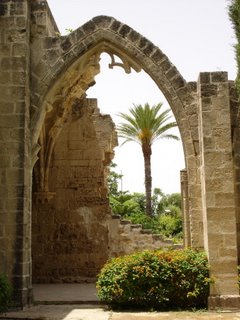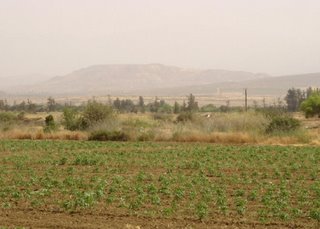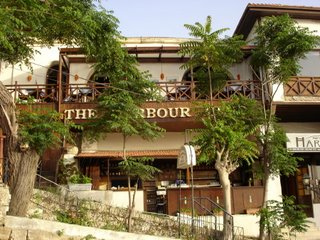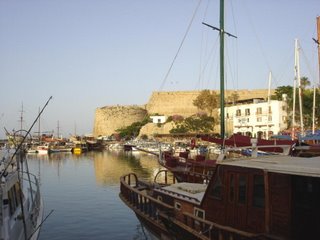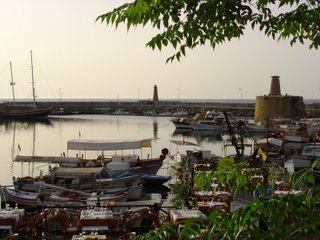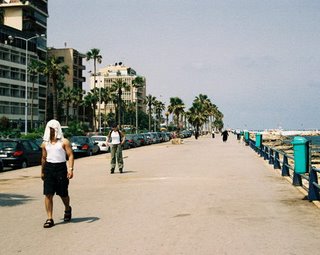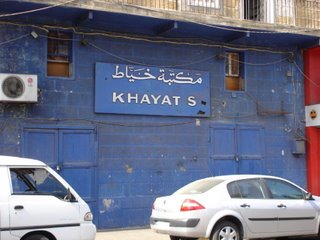Finally, I must comment on the terrible destruction in the beautiful land I just returned from.
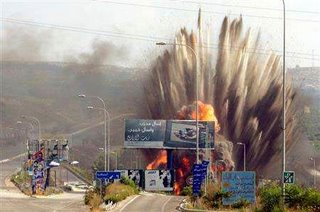 The pictures you see on this site no longer reflect what is there. Anyone who reads the news knows that devastation replaces the rebuilding that had taken place in Lebanon. Most Americans, however, have no idea of what is really happening in the Middle East. That ignorance extends to most Westerners. The media coverage is very biased. If you will re-read my postings from Beirut, you will notice that we were prevented from taking our field trip to Sidon, in the south of Lebanon, because Israel had bombed the area. That was weeks before Hezbollah abducted the soldiers from the northern part of Israel. I have heard from those in the know, that in the interim, Israel conducted fly-overs repeatedly, creating sonic-booms that terrorized the residents in south Lebanon. Frequently, they would bomb the power plants, plunging the city of Beirut into darkness for hours. Our friends, Alice and Rae, commented that during the week we were in Beirut, it was the first time in a long while that they hadn't had a power-outage of some duration.
The pictures you see on this site no longer reflect what is there. Anyone who reads the news knows that devastation replaces the rebuilding that had taken place in Lebanon. Most Americans, however, have no idea of what is really happening in the Middle East. That ignorance extends to most Westerners. The media coverage is very biased. If you will re-read my postings from Beirut, you will notice that we were prevented from taking our field trip to Sidon, in the south of Lebanon, because Israel had bombed the area. That was weeks before Hezbollah abducted the soldiers from the northern part of Israel. I have heard from those in the know, that in the interim, Israel conducted fly-overs repeatedly, creating sonic-booms that terrorized the residents in south Lebanon. Frequently, they would bomb the power plants, plunging the city of Beirut into darkness for hours. Our friends, Alice and Rae, commented that during the week we were in Beirut, it was the first time in a long while that they hadn't had a power-outage of some duration.I reiterate, this was weeks before the soldiers were taken. It is clear to me from the reaction of our president to this outrageous occurance, that the United States figures into this carnage some how. I want to publicly apologize to the people of Lebanon for the actions, or non-actions, or both, of the American government. There is no excuse for the extreme loss of civilian lives and the wanton destruction of your beautiful country. I know you will rise again, but in the meantime, I mourn with you for all that you have lost.
Here is a well-written comment from a writer I respect:
Robert Fisk's Elegy for Beirut
The Independent
July 19, 2006
Elegant buildings lie in ruins. The heady scent of gardenias gives way to the acrid stench of bombed-out oil installations. And everywhere terrified people are scrambling to get out of a city that seems tragically doomed to chaos and destruction. As Beirut - 'the Paris of the (Middle) East' - is defiled yet again.
In the year 551, the magnificent, wealthy city of Berytus - headquarters of the imperial East Mediterranean Roman fleet - was struck by a massive earthquake. In its aftermath, the sea withdrew several miles and the survivors - ancestors of the present-day Lebanese - walked out on the sands to loot the long-sunken merchant ships revealed in front of them.
That was when a tidal wall higher than a tsunami returned to swamp the city and kill them all. So savagely was the old Beirut damaged that the Emperor Justinian sent gold from Constantinople as compensation to every family left alive.
How does this happen to Beirut? For 30 years, I've watched this place die and then rise from the grave and then die again, its apartment blocks pitted with so many bullets they looked like Irish lace, its people massacring each other.
I lived here through 15 years of civil war that took 150,000 lives, and two Israeli invasions and years of Israeli bombardments that cost the lives of a further 20,000 of its people. I have seen them armless, legless, headless, knifed, bombed and splashed across the walls of houses. Yet they are a fine, educated, moral people whose generosity amazes every foreigner, whose gentleness puts any Westerner to shame, and whose suffering we almost always ignore.
They look like us, the people of Beirut. They have light-coloured skin and speak beautiful English and French. They travel the world. Their women are gorgeous and their food exquisite. But what are we saying of their fate today as the Israelis - in some of their cruellest attacks on this city and the surrounding countryside - tear them from their homes, bomb them on river bridges, cut them off from food and water and electricity? We say that they started this latest war, and we compare their appalling casualties - 240 in all of Lebanon by last night - with Israel's 24 dead, as if the figures are the same.
And then, most disgraceful of all, we leave the Lebanese to their fate like a diseased people and spend our time evacuating our precious foreigners while tut-tutting about Israel's "disproportionate" response to the capture of its soldiers by Hizbollah.
I walked through the deserted city centre of Beirut yesterday and it reminded more than ever of a film lot, a place of dreams too beautiful to last, a phoenix from the ashes of civil war whose plumage was so brightly coloured that it blinded its own people. This part of the city - once a Dresden of ruins - was rebuilt by Rafiq Hariri, the prime minister who was murdered scarcely a mile away on 14 February last year.
The wreckage of that bomb blast, an awful precursor to the present war in which his inheritance is being vandalised by the Israelis, still stands beside the Mediterranean, waiting for the last UN investigator to look for clues to the assassination - an investigator who has long ago abandoned this besieged city for the safety of Cyprus.
At the empty Etoile restaurant - best snails and cappuccino in Beirut, where Hariri once dined Jacques Chirac - I sat on the pavement and watched the parliamentary guard still patrolling the façade of the French-built emporium that houses what is left of Lebanon's democracy. So many of these streets were built by Parisians under the French mandate and they have been exquisitely restored, their mock Arabian doorways bejewelled with marble Roman columns dugfrom the ancient Via Maxima a few metres away.
Hariri loved this place and, taking Chirac for a beer one day, he caught sight of me sitting at a table. "Ah Robert, come over here," he roared and then turned to Chirac like a cat that was about to eat a canary. "I want to introduce you, Jacques, to the reporter who said I couldn't rebuild Beirut!"
And now it is being un-built. The Martyr Rafiq Hariri International Airport has been attacked three times by the Israelis, its glistening halls and shopping malls vibrating to the missiles that thunder into the runways and fuel depots. Hariri's wonderful transnational highway viaduct has been broken by Israeli bombers. Most of his motorway bridges have been destroyed. The Roman-style lighthouse has been smashed by a missile from an Apache helicopter. Only this small jewel of a restaurant in the centre of Beirut has been spared. So far.
It is the slums of Haret Hreik and Ghobeiri and Shiyah that have been levelled and "rubble-ised" and pounded to dust, sending a quarter of a million Shia Muslims to seek sanctuary in schools and abandoned parks across the city. Here, indeed, was the headquarters of Hizbollah, another of those "centres of world terror" which the West keeps discovering in Muslim lands. Here lived Sayed Hassan Nasrallah, the Party of God's leader, a ruthless, caustic, calculating man; and Sayad Mohamed Fadlallah, among the wisest and most eloquent of clerics; and many of Hizbollah's top military planners - including, no doubt, the men who planned over many months the capture of the two Israeli soldiers last Wednesday.
But did the tens of thousands of poor who live here deserve this act of mass punishment? For a country that boasts of its pin-point accuracy - a doubtful notion in any case, but that's not the issue - what does this act of destruction tell us about Israel? Or about ourselves?
In a modern building in an undamaged part of Beirut, I come, quite by chance, across a well known and prominent Hizbollah figure, open-neck white shirt, dark suit, clean shoes. "We will go on if we have to for days or weeks or months or..." And he counts these awful statistics off on the fingers of his left hand. "Believe me, we have bigger surprises still to come for the Israelis - much bigger, you will see. Then we will get our prisoners and it will take just a few small concessions."
I walk outside, feeling as if I have been beaten over the head. Over the wall opposite there is purple bougainvillaea and white jasmine and a swamp of gardenias. The Lebanese love flowers, their colour and scent, and Beirut is draped in trees and bushes that smell like paradise.
As for the huddled masses from the powder of the bombed-out southern slums of Haret Hreik, I found hundreds of them yesterday, sitting under trees and lying on the parched grass beside an ancient fountain donated to the city of Beirut by the Ottoman Sultan Abdul-Hamid. How empires fall.
Far away, across the Mediterranean, two American helicopters from the USS Iwo Jima could be seen, heading through the mist and smoke towards the US embassy bunker complex at Awkar to evacuate more citizens of the American Empire. There was not a word from that same empire to help the people lying in the park, to offer them food or medical aid.
And across them all has spread a dark grey smoke that works its way through the entire city, the fires of oil terminals and burning buildings turning into a cocktail of sulphurous air that moves below our doors and through our windows. I smell it when I wake in the morning. Half the people of Beirut are coughing in this filth, breathing their own destruction as they contemplate their dead.
The anger that any human soul should feel at such suffering and loss was expressed so well by Lebanon's greatest poet, the mystic Khalil Gibran, when he wrote of the half million Lebanese who died in the 1916 famine, most of them residents of Beirut:
My people died of hunger, and he who
Did not perish from starvation was
Butchered with the sword;
They perished from hunger
In a land rich with milk and honey.
They died because the vipers and
Sons of vipers spat out poison into
The space where the Holy Cedars and
The roses and the jasmine breathe
Their fragrance.
And the sword continues to cut its way through Beirut. When part of an aircraft perhaps the wing-tip of an F-16 hit by a missile, although the Israelis deny this - came streaking out of the sky over the eastern suburbs at the weekend, I raced to the scene to find a partly decapitated driver in his car and three Lebanese soldiers from the army's logistics unit. These are the tough, brave non-combat soldiers of Kfar Chim, who have been mending power and water lines these past six days to keep Beirut alive.
I knew one of them. "Hello Robert, be quick because I think the Israelis will bomb again but we'll show you everything we can." And they took me through the fires to show me what they could of the wreckage, standing around me to protect me.
And a few hours later, the Israelis did come back, as the men of the small logistics unit were going to bed, and they bombed the barracks and killed 10 soldiers, including those three kind men who looked after me amid the fires of Kfar Chim.
And why? Be sure - the Israelis know what they are hitting. That's why they killed nine soldiers near Tripoli when they bombed the military radio antennas. But a logistics unit? Men whose sole job was to mend electricity lines? And then it dawns on me. Beirut is to die. It is to be starved of electricity now that the power station in Jiyeh is on fire. No one is to be allowed to keep Beirut alive. So those poor men had to be liquidated.
Beirutis are tough people and are not easily moved. But at the end of last week, many of them were overcome by a photograph in their daily papers of a small girl, discarded like a broken flower in a field near Ter Harfa, her feet curled up, her hand resting on her torn blue pyjamas, her eyes - beneath long, soft hair - closed, turned away from the camera. She had been another "terrorist" target of Israel and several people, myself among them, saw a frightening similarity between this picture and the photograph of a Polish girl lying dead in a field beside her weeping sister in 1939.
I go home and flick through my files, old pictures of the Israeli invasion of 1982. There are more photographs of dead children, of broken bridges. "Israelis Threaten to Storm Beirut", says one headline. "Israelis Retaliate". "Lebanon At War". "Beirut Under Siege". "Massacre at Sabra and Chatila".
Yes, how easily we forget these earlier slaughters. Up to 1,700 Palestinians were butchered at Sabra and Chatila by Israel's proxy Christian militia allies in September of 1982 while Israeli troops - as they later testified to Israel's own court of inquiry - watched the killings. I was there. I stopped counting the corpses when I reached 100. Many of the women had been raped before being knifed or shot.
Yet when I was fleeing the bombing of Ghobeiri with my driver Abed last week, we swept right past the entrance of the camp, the very spot where I saw the first murdered Palestinians. And we did not think of them. We did not remember them. They were dead in Beirut and we were trying to stay alive in Beirut, as I have been trying to stay alive here for 30 years.
I am back on the sea coast when my mobile phone rings. It is an Israeli woman calling me from the United States, the author of a fine novel about the Palestinians. "Robert, please take care," she says. "I am so, so sorry about what is being done to the Lebanese. It is unforgivable. I pray for the Lebanese people, and the Palestinians, and the Israelis." I thank her for her thoughtfulness and the graceful, generous way she condemned this slaughter.
Then, on my balcony - a glance to check the location of the Israeli gunboat far out in the sea-smog - I find older clippings. This is from an English paper in 1840, when Beirut was a great Ottoman city. "Beyrouth" was the dateline. "Anarchy is now the order of the day, our properties and personal safety are endangered, no satisfaction can be obtained, and crimes are committed with impunity. Several Europeans have quitted their houses and suspended their affairs, in order to find protection in more peaceable countries."
On my dining-room wall, I remember, there is a hand-painted lithograph of French troops arriving in Beirut in 1842 to protect the Christian Maronites from the Druze. They are camping in the Jardin des Pins, which will later become the site of the French embassy where, only a few hours ago, I saw French men and women registering for their evacuation. And outside the window, I hear again the whisper of Israeli jets, hidden behind the smoke that now drifts 20 miles out to sea.
Fairouz, the most popular of Lebanese singers, was to have performed at this year's Baalbek festival, cancelled now like all Lebanon's festivals of music, dance, theatre and painting. One of her most popular songs is dedicated to her native city:
To Beirut - peace to Beirut with all my heart
And kisses - to the sea and clouds,
To the rock of a city that looks like an old sailor's face.
From the soul of her people she makes wine,
From their sweat, she makes bread and jasmine.
So how did it come to taste of smoke and fire?
© 2006 Independent News and Media Limited.
*****************************************
And another chapter by Fisk:
Blair and his masters regard ceasefires as a weapon, a means to a political end
Published: 29 July 2006
I dropped by the hospital in Marjayoun this week to find a young girl lying in a hospital bed, swathed in bandages, her beauty scarred for ever by some familiar wounds; the telltale dark-red holes in her skin made by cluster bombs, the weapon we used in Iraq to such lethal effect and which the Israelis are now using to punish the civilians of southern Lebanon.
And, of course, it occurred to me at once that if George Bush and Condoleezza Rice and our own sad and diminished Prime Minister (Fisk is from the UK) had demanded a ceasefire when the Lebanese first pleaded for it, this young woman would not have to spend the rest of her life pitted with these vile scars.And having seen the cadavers of so many more men and women, I have to say - from my eyrie only three miles from the Israeli border - that the compliant, gutless, shameful refusal of Bush, Rice and Lord Blair of Kut al-Amara to bring this bloodbath to an end sentenced many hundreds of innocent Lebanese to death. As I write this near the
Let the war last longer and the suffering grow greater - let compassion be postponed - and the Lebanese (and, most laughably, the Hizbollah) will eventually sink to their knees and accept the West's ridiculous demands. And one of those famous American "opportunities" for change - ie for humbling
Hence, in the revolting words of Lord Blair's flunky yesterday, Blair will "increase the urgency" of diplomacy. Think about that for a moment. Diplomacy wasn't urgent at the beginning. Then I suppose it became fairly urgent and now this mendacious man is going to "increase" the urgency of diplomacy; after which, I suppose, it can become super-urgent or of "absolutely" paramount importance, the time decided - no doubt - by Israel's belief that it has won the war against Hizbollah or, more likely, because Israel realises that it is an unwinnable war and wants us to take the casualties.
Yet from the border of
Posted 3 August 2006
I am entering this out of sequence so as to keep it under the heading of the destruction of Beirut. I do not want this to become a chronical of the war in Lebanon. Because blogs show the most recent posting first, readers would be greeted by off-topic postings when they arrive at this site. So, forgive me for adding these comments out-of-order.
The following quotes come from a blogger named Zena in Beirut. She took photographs of the port of Byblos, one of the places I visit on my trip to Lebanon. The oil spill apparently resulted from the bombing of the power station by the Israeli planes. In reading Zena's words, you can get a sense of the futility and the fear that the people of Lebanon are experiencing these days. Many of the illnesses that are being reported can be attributed to the depleated uranium in the bombs, the acrid smoke from burning buildings, and the simple stress of fear.

The Port of Byblos - notice the oil-slicked water.
Here is Zena's post:
Sunday, July 30, 2006
chasing oil
yesterday, a few of us got into a car and drove up the Lebanese coast line, northwards...in order to document the oil spill. we took pictures, video, and prepared a map that traced the movement of the oil slick.
though i was on the edge of having a panic attack the whole time, being afraid that at any time, the road, bridge or tunnel we were on could be bombed... it felt good to finally get out of beirut for a few hours... first time in a long time.
what we saw was horrendous. our glorious beaches... all covered in black. bays, rocks, crevices, hidden under a blanket of oil. i can not tell you how big this spill is. we went as far up as Anfe (which is about 10 minutes before Tripoli) before we had to turn back to Beirut in order to make it to our evening interviews on time. the oil slick continues to travel north, eating up everything in its path. we heard it was reached Syria now.
Byblos (Jbeil) bay is completely smothered. this once picturesque and touristic town, also the oldest port city on Earth, is in ruins. we could smell the oil before we were anywhere close to the bay. this summer, the town was planning to celebrate its 7,000th birthday! there were huge festivities planned... so much went into it... now... nothing but this black plague.
we stopped to speak with a few fishermen. they are completely devastated. they have no means of income anymore. so many of them had fixed up their boats for this summer i hopes of giving tourists small boat trips around the coast. now, that is gone too.
i had a really bad headache all day... we were driving on the coastal road, stopped every few minutes to document.... the smell was so strong. when i got home, i blew my nose and the tissue was all black. i made sure to take a really good shower.
we were going to send out the press release, pics and video today, but we got even worse news...
there had been a massacre in Qana early this morning. history repeats itself. the Israelis dropped a bomb on a building that was sheltering refugees. the news at this point is that 55 were killed. mostly women and children... but the numbers are growing. the news is still fresh. it was only a few years ago that the Israelis did the same thing, except last time, it was a UN building that they hit. and over 100 people were killed. mostly women and children killed... why?? how can anyone be so inhumane?
i think Israel is the only country in the world that is allowed to hit UN posts and get away with it. only a few days ago, a UN post was hit in the South. UN peacekeepers died. to their families, i beg forgiveness. Lebanon is a beautiful country.. full of beautiful people. we all mourn your loss.
this whole attack has been one massacre after another. and still they persist. and still, it continues...
Another post:
Tuesday, August 01, 2006
black dust
there is a black dust that is filling the air. we are breathing it in ... constantly. it has settled on my clothes, in my kitchen... it is everywhere. we are guessing it is from the Jiye power station that was bombed... it is still on fire... it is the power station from which the oil spill originated from.
today i had my first experience at queuing for gas. the shortages have arrived. so many gas stations have shut down. the few that are left have long queues.. i waited for 40 minutes.. and when my turn came, i was give $10 worth only.
i only have a few minutes left before the electricity gets cut. we are running on generator now and they usually turn it off at midnight...
everyone is talking about the depleted uranium in the bombs... it is everywhere now. in the air we breathe.. in the land... it will soon be in our crops... in our water... wow. every time i think that things can't get worse, they do.
i am already envisioning myself with cancer. i can feel it all around me. i don't know if i could be as strong as maya has been.
maya by the way is doing ok. she is now on about 5 different pain killers... they make her funny. whenever i call she answers... "hello. maya's house of pain.. can i help you." hehe. it's funnier when you hear it on the phone.
the sky is so dark tonight. there is no moon. beirut is quiet. death is all around me.
And lastly:
Wednesday, August 02, 2006
bye bye beirut
just got home.. was driving like crazy... word on the street is that Israel is threatening to hit Beirut now... i feel so helpless... i called Maya, she said that if she dies today that i could keep her dvds that i'm borrowing... i told her the same.
i called my husband and told him to come home right away. if i die, i want to be in his arms...
... my little brother is here with me. he is 20 years old. he is making some tea now. he believes it is going to be ok. we are supposed to be discussing a plan he has to make t-shirts with slogans on them to raise money for the relief shelter he is volunteering at.
this could be my last entry.. maybe...
i have thought of that every time i put up an entry... but today, i am writing it with real fear in my heart.
the violence continues... the hating continues...
how can we stop this? please help to stop this.
i am only 30 years old. i have not had children. i want children. i want to live. i want to grow old with my husband... i want my children to play with my friends children... simple things, i want.
i want to breathe good air again. i want to wake up without my stomach in a knot. i want to stop coughing and vomiting. i want to continue to believe in humanity.
my head is spinning from anxiety.
i will not accept death. it is not my time. there is still so much in life to experience... i want to smile.. and laugh... simple things, i want.
i will not say goodbye... i refuse to say goodbye.
Want to read more from Zena? Click here: Beirut Update


